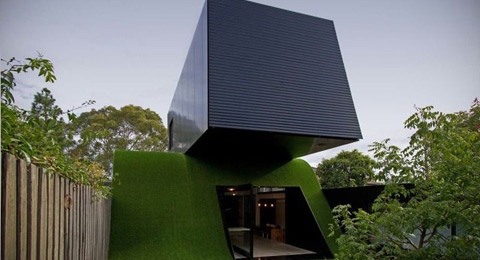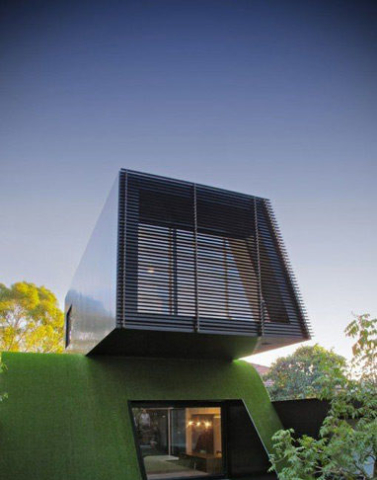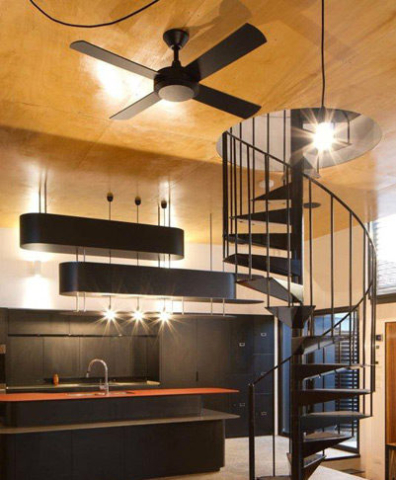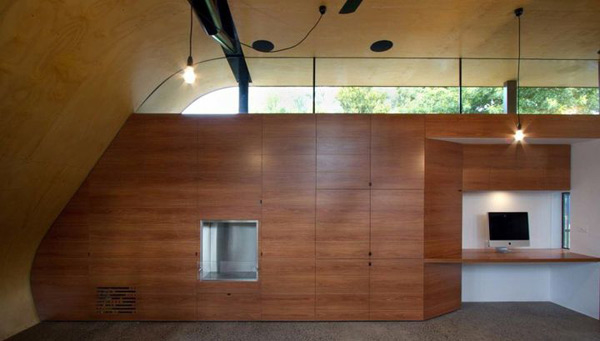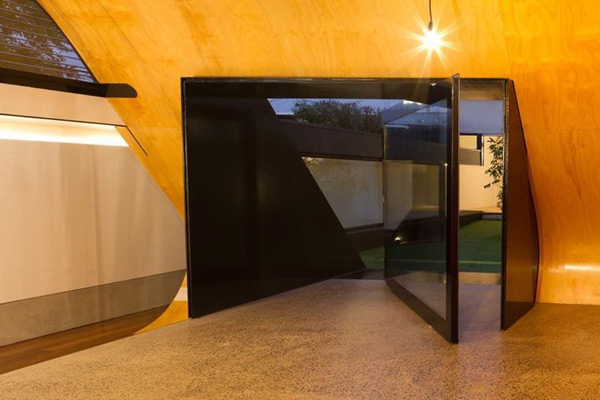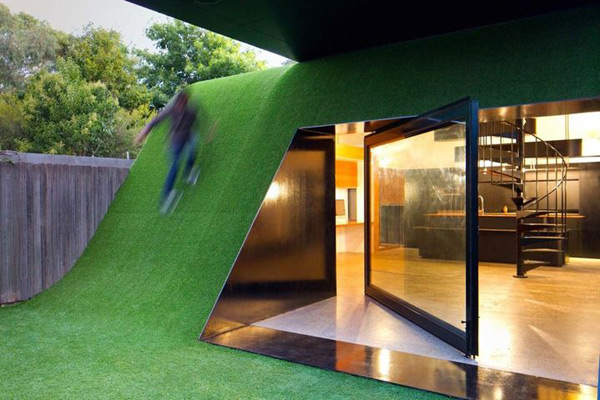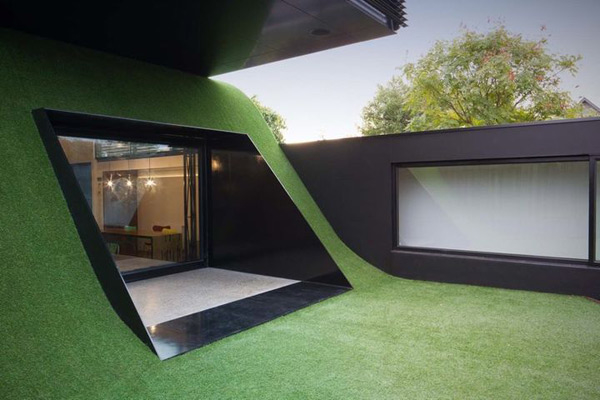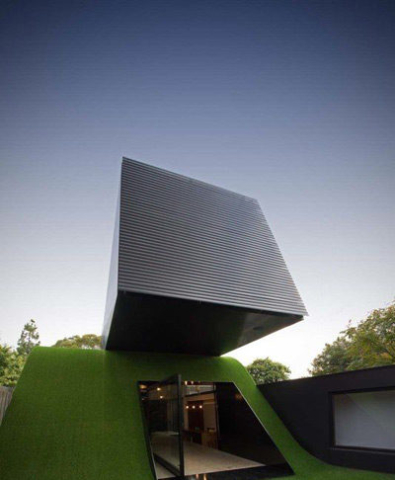Andrew Maynard Architects
Problem/prilika
Dizajn je kompleksan. Dizajn kuće je jedan od najsloženijih poduhvata, međutim fundamentalni problemi pružaju početno polazište; gde su pozicije sunca? Kako da ga iskoristimo zimi i kako da ga izolujemo leti?
Uzane parcele severnog predgrađa Melburna često su nezgodne za projektovanje u pogledu solarne iskorišćenosti i zbog toga zahtevaju rešenja u vidu nestandardnih ideja koje prevazilaze ove prepreke i pretvaraju ih u prilike.
Original uslovi
Parcela je orjentisana ka severu tako da je zadnje dvorište, porodični primarni otvoreni prostor, u senci tokom cele godine. 90tih godina dvospratno proširenje je još više smanjivalo prodor sunca stvarajući tako dubok taman prostor u okviru kuće. Petočlana porodica želela je da stvori kuću za život koja bi mogla da zadovolji potrebe troje male dece i njihovu transformaciju u odrasle osobe.
Odgovor
Umesto ponavljanja greške iz prošlosti i proširivanja sa zadnje strane, dat je predlog da se nova struktura gradi na krajnjem delu, južnom obodu bloka, na površini dosadašnjeg dvorišta. Nova struktura je orjentisana ka suncu – čista konzolna kutija služi kao pasivna solarna streha koja štiti od letnjeg sunca, a zimsko propušta unutra.
Nakon odluke da se gradi u zadnjem delu bloka osmišljena je moderna kutija. Uskoro se javila ideja da se iskoristi prilika i aktivira ova nova, nekada u senci, sada sunčana fasada. Sedišta duž nove severne fasade? Možda niz stepenica kao u Scalinata della Trinità dei Monti? Ali kako se izležavati na suncu na stepenicama? Možda neki nagib umesto stepenica … I tako je nastala Kuća na brdu.
Nova struktura okrenuta je ka originalnoj kući. Dvorište je sad centar kuće aktiviran izgrađenom formom. Pored solarne dobiti, pozicioniranje nove strukture u okviru dvorišta učinilo je da kuća koristi i pejzaž iz susednih bašti. Visoki prozori kabineta zabave i trpezarije su obavijeni drvećem. Iz unutrašnjosti objekta izgleda kao da je kuća okružena šumom, a ne suburbanim tkivom.
Forma
Andrew je poreklom iz Tasmanije, mesta kojim dominira njegov pejzaž. Izgrađena forma je sekundarna i podređena pejzažu. Melburn je pretežno ravan. Može li ovo biti razlog zbog koga je arhitektura Melburna avanturistička? Ne postoji pejzaž koji okružuje objekat tako da objekat može preuzeti ulogu pejzaža. Kuća na brdu je odgovor na ovu verovatnu pojavu. Melburn je ravan. Ukoliko neko želi da istraži konzolni oblik nad liticom, što je želja mnogih arhitekata, on mora napraviti pejzaž za to. Monolitan oblik je odvojen od brda i postavljen odozgo – naglašavanje sintetičkog i proizvedenog. Talasast pejzaž i čista arhitektonska forma.
Andrew Maynard Architects
The problem/opportunity
Design is complex. There is little that is more complex to design than a home, however fundamental issues offer an architect a starting point; where is the sun? How do we capture it in winter, how do we exclude it in summer?
The thin allotments that dominate Melbourne’s northern suburbs often provide indomitable constraints to solar access and therefore require the production of unorthodox ideas to overcome these constraints and convert them into opportunities.
Original conditions
The site faces north therefore relegating the backyard, the family’s primary outdoor space, to shadow throughout the year. In the 90s a two storey extension was added reducing solar access even further while creating deep dark space within the house. A family of five wished to create a long-term home, which could meet the requirements of three small children and their slow transformation into young adults over the years.
Response
Rather than repeating past mistakes and extending from the rear in a new configuration, the proposal was to build a new structure on the rear boundary, the southern edge of the block, upon the footprint of what had been, until now, the back yard. The new structure faces the sun, the pure cantilevered box above acts as the passive solar eave, cutting out summer sun, while letting winter sun flood in.
Following the decision to build at the rear of the block a ubiquitous modern box was first imagined. Soon it seemed necessary to pursue the opportunity to activate this new, once shaded, now sunny facade. A seat along the new northern facade? Perhaps a series of steps like the Scalinata della Trinità dei Monti? But how does one lounge in the sun on steps. Perhaps a slope instead …. And the hill house evolved/emerged.
The new structure faces the original house. The backyard is now the centre of the house activated by the built form around it. Beyond solar gain, thebenefit of the new structure being in the backyard is that it borrows landscaping from its neighbours’ gardens. The high windows about the entertainment cabinetry and the dining area are enveloped in trees. Internally one gets the sense that Hill House is enveloped by bush rather than part of the suburban mix.
Form
Andrew is from Tasmania, a place dominated by its landscape. Built form is secondary and subservient to landscape. Melbourne is predominantly flat. Could this be why Melbourne’s architecture is adventurous? There is no landscape to confine therefore building is free to become landscape. Hill House is a response to this possibility. Melbourne is flat. If one is to explore the possibility of cantilevering off a cliff (a desire of many architects) one is forced to manufacture that landscape. A monolithic form is unsheathed from the hill and placed atop. A celebration of the synthetic, the manufactured. A simulacrum of both an undulating landscape and the pure architectural form.


